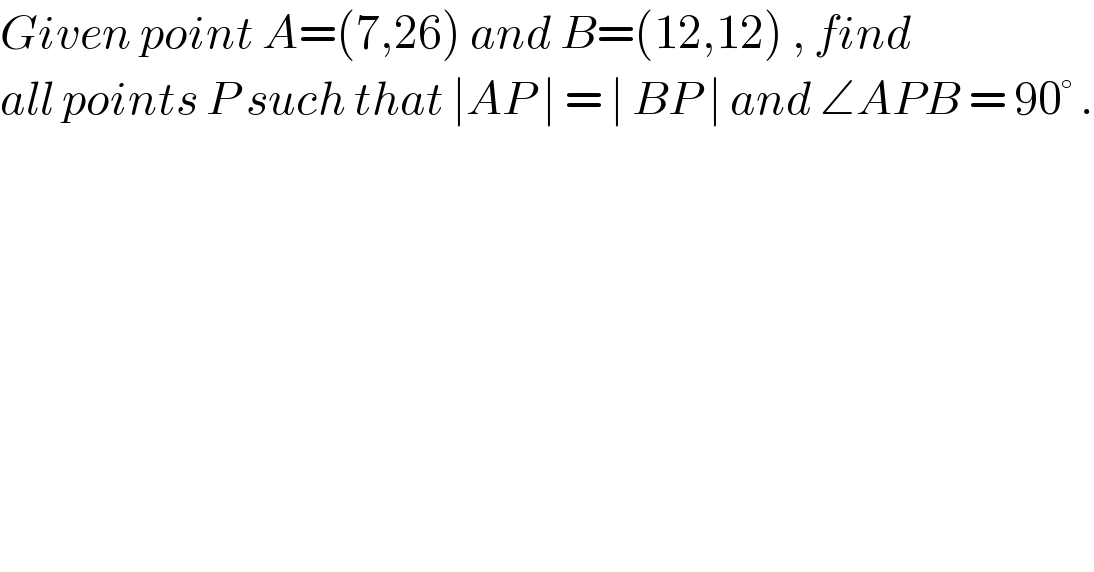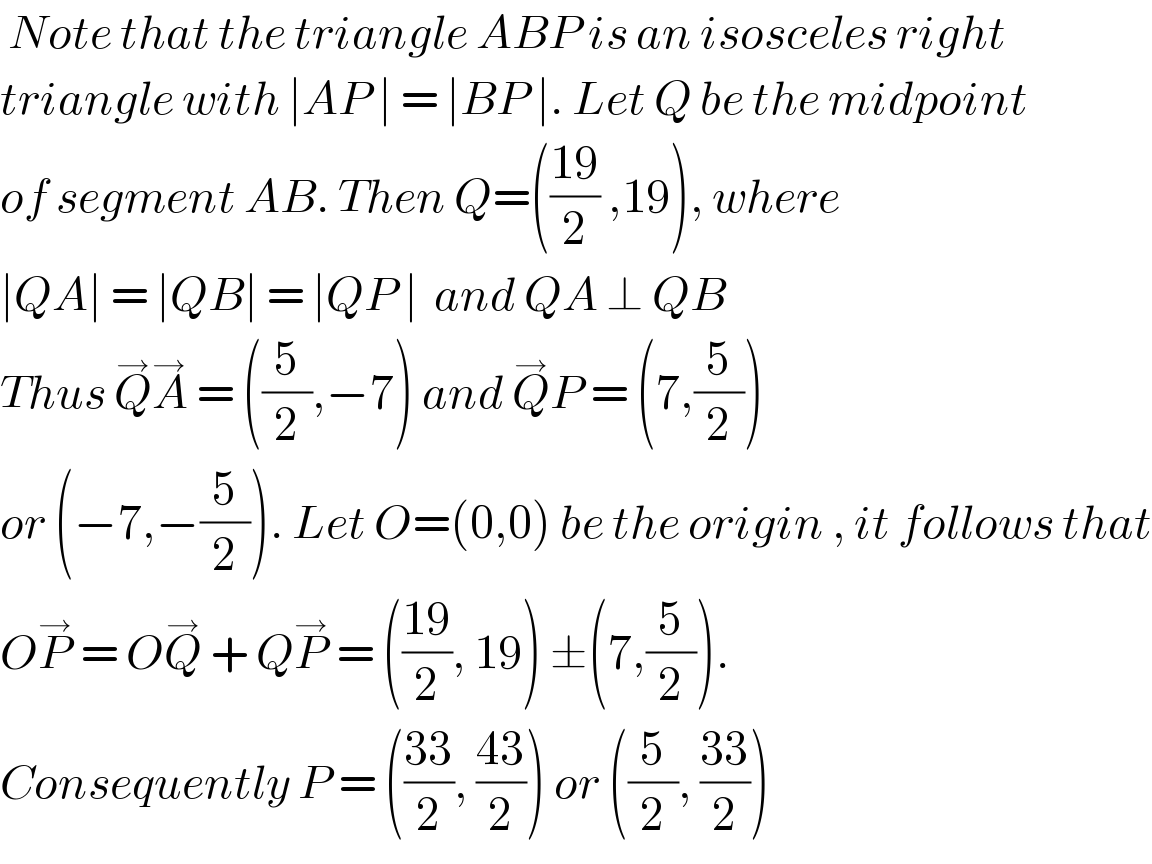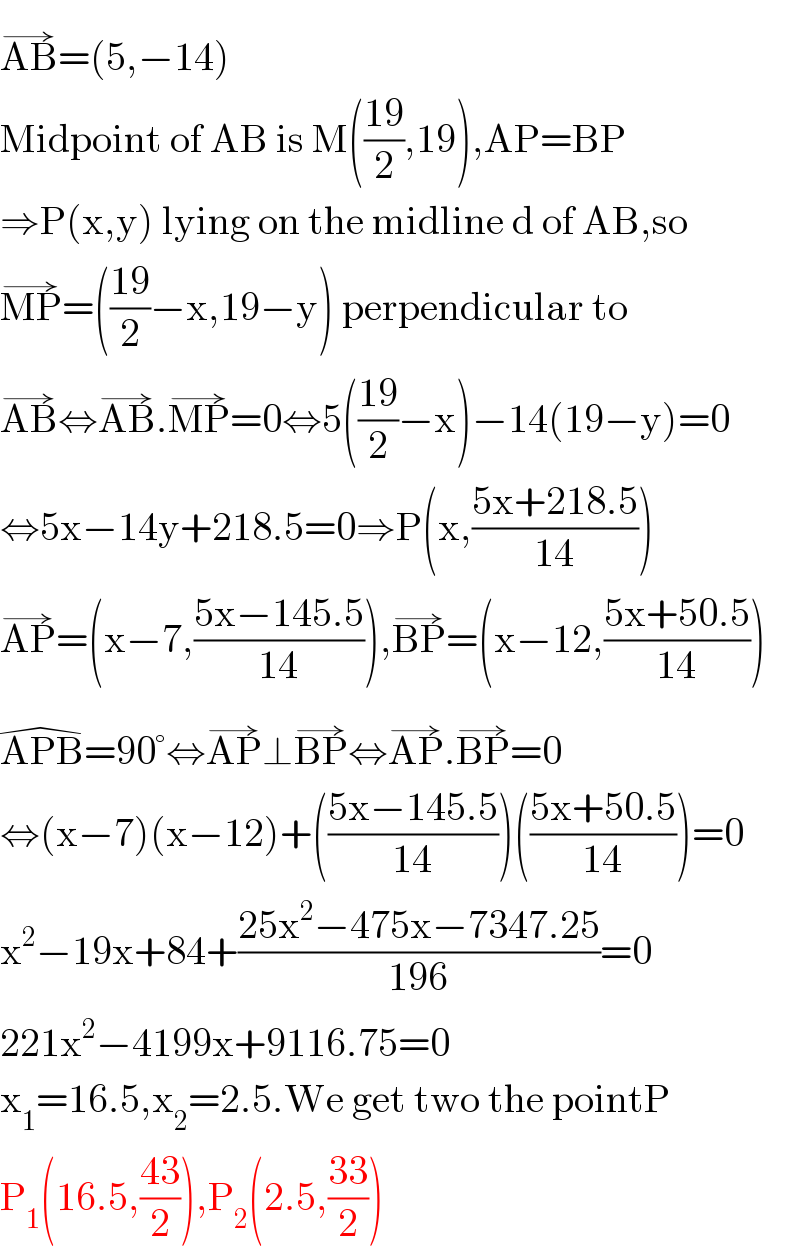Question Number 119007 by bramlexs22 last updated on 21/Oct/20

$${Given}\:{point}\:{A}=\left(\mathrm{7},\mathrm{26}\right)\:{and}\:{B}=\left(\mathrm{12},\mathrm{12}\right)\:,\:{find} \\ $$$${all}\:{points}\:{P}\:{such}\:{that}\:\mid{AP}\:\mid\:=\:\mid\:{BP}\:\mid\:{and}\:\angle{APB}\:=\:\mathrm{90}°\:. \\ $$
Answered by bemath last updated on 21/Oct/20

$$\:{Note}\:{that}\:{the}\:{triangle}\:{ABP}\:{is}\:{an}\:{isosceles}\:{right} \\ $$$${triangle}\:{with}\:\mid{AP}\:\mid\:=\:\mid{BP}\:\mid.\:{Let}\:{Q}\:{be}\:{the}\:{midpoint} \\ $$$${of}\:{segment}\:{AB}.\:{Then}\:{Q}=\left(\frac{\mathrm{19}}{\mathrm{2}}\:,\mathrm{19}\right),\:{where} \\ $$$$\mid{QA}\mid\:=\:\mid{QB}\mid\:=\:\mid{QP}\:\mid\:\:{and}\:{QA}\:\bot\:{QB} \\ $$$${Thus}\:\overset{\rightarrow} {{Q}}\overset{\rightarrow} {{A}}\:=\:\left(\frac{\mathrm{5}}{\mathrm{2}},−\mathrm{7}\right)\:{and}\:\overset{\rightarrow} {{Q}P}\:=\:\left(\mathrm{7},\frac{\mathrm{5}}{\mathrm{2}}\right)\: \\ $$$${or}\:\left(−\mathrm{7},−\frac{\mathrm{5}}{\mathrm{2}}\right).\:{Let}\:{O}=\left(\mathrm{0},\mathrm{0}\right)\:{be}\:{the}\:{origin}\:,\:{it}\:{follows}\:{that} \\ $$$${O}\overset{\rightarrow} {{P}}\:=\:{O}\overset{\rightarrow} {{Q}}\:+\:{Q}\overset{\rightarrow} {{P}}\:=\:\left(\frac{\mathrm{19}}{\mathrm{2}},\:\mathrm{19}\right)\:\pm\left(\mathrm{7},\frac{\mathrm{5}}{\mathrm{2}}\right). \\ $$$${Consequently}\:{P}\:=\:\left(\frac{\mathrm{33}}{\mathrm{2}},\:\frac{\mathrm{43}}{\mathrm{2}}\right)\:{or}\:\left(\frac{\mathrm{5}}{\mathrm{2}},\:\frac{\mathrm{33}}{\mathrm{2}}\right) \\ $$
Answered by 1549442205PVT last updated on 21/Oct/20

$$\overset{\rightarrow} {\mathrm{AB}}=\left(\mathrm{5},−\mathrm{14}\right) \\ $$$$\mathrm{Midpoint}\:\mathrm{of}\:\mathrm{AB}\:\mathrm{is}\:\mathrm{M}\left(\frac{\mathrm{19}}{\mathrm{2}},\mathrm{19}\right),\mathrm{AP}=\mathrm{BP} \\ $$$$\Rightarrow\mathrm{P}\left(\mathrm{x},\mathrm{y}\right)\:\mathrm{lying}\:\mathrm{on}\:\mathrm{the}\:\mathrm{midline}\:\mathrm{d}\:\mathrm{of}\:\mathrm{AB},\mathrm{so} \\ $$$$\overset{\rightarrow} {\mathrm{MP}}=\left(\frac{\mathrm{19}}{\mathrm{2}}−\mathrm{x},\mathrm{19}−\mathrm{y}\right)\:\mathrm{perpendicular}\:\mathrm{to} \\ $$$$\overset{\rightarrow} {\mathrm{AB}}\Leftrightarrow\overset{\rightarrow} {\mathrm{AB}}.\overset{\rightarrow} {\mathrm{MP}}=\mathrm{0}\Leftrightarrow\mathrm{5}\left(\frac{\mathrm{19}}{\mathrm{2}}−\mathrm{x}\right)−\mathrm{14}\left(\mathrm{19}−\mathrm{y}\right)=\mathrm{0} \\ $$$$\Leftrightarrow\mathrm{5x}−\mathrm{14y}+\mathrm{218}.\mathrm{5}=\mathrm{0}\Rightarrow\mathrm{P}\left(\mathrm{x},\frac{\mathrm{5x}+\mathrm{218}.\mathrm{5}}{\mathrm{14}}\right) \\ $$$$\overset{\rightarrow} {\mathrm{AP}}=\left(\mathrm{x}−\mathrm{7},\frac{\mathrm{5x}−\mathrm{145}.\mathrm{5}}{\mathrm{14}}\right),\overset{\rightarrow} {\mathrm{BP}}=\left(\mathrm{x}−\mathrm{12},\frac{\mathrm{5x}+\mathrm{50}.\mathrm{5}}{\mathrm{14}}\right) \\ $$$$\widehat {\mathrm{APB}}=\mathrm{90}°\Leftrightarrow\overset{\rightarrow} {\mathrm{AP}}\bot\overset{\rightarrow} {\mathrm{BP}}\Leftrightarrow\overset{\rightarrow} {\mathrm{AP}}.\overset{\rightarrow} {\mathrm{BP}}=\mathrm{0} \\ $$$$\Leftrightarrow\left(\mathrm{x}−\mathrm{7}\right)\left(\mathrm{x}−\mathrm{12}\right)+\left(\frac{\mathrm{5x}−\mathrm{145}.\mathrm{5}}{\mathrm{14}}\right)\left(\frac{\mathrm{5x}+\mathrm{50}.\mathrm{5}}{\mathrm{14}}\right)=\mathrm{0} \\ $$$$\mathrm{x}^{\mathrm{2}} −\mathrm{19x}+\mathrm{84}+\frac{\mathrm{25x}^{\mathrm{2}} −\mathrm{475x}−\mathrm{7347}.\mathrm{25}}{\mathrm{196}}=\mathrm{0} \\ $$$$\mathrm{221x}^{\mathrm{2}} −\mathrm{4199x}+\mathrm{9116}.\mathrm{75}=\mathrm{0} \\ $$$$\mathrm{x}_{\mathrm{1}} =\mathrm{16}.\mathrm{5},\mathrm{x}_{\mathrm{2}} =\mathrm{2}.\mathrm{5}.\mathrm{We}\:\mathrm{get}\:\mathrm{two}\:\mathrm{the}\:\mathrm{pointP} \\ $$$$\mathrm{P}_{\mathrm{1}} \left(\mathrm{16}.\mathrm{5},\frac{\mathrm{43}}{\mathrm{2}}\right),\mathrm{P}_{\mathrm{2}} \left(\mathrm{2}.\mathrm{5},\frac{\mathrm{33}}{\mathrm{2}}\right) \\ $$
